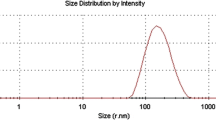Abstract
In this paper, the peppermint oil/HP-β-CD (2-hydroxypropyl-β-cyclodextrin)/chitosan composite microcapsules were prepared. The release ability of these microcapsules was improved for peppermint oil through the combination of molecular encapsulation by HP-β-CD and physical encapsulation by chitosan shell. First, stable peppermint oil/HP-β-CD pre-emulsion was prepared by stirring, based on which the optimal conditions were determined for producing the pre-emulsions with the highest encapsulation efficiency. Then, the pre-emulsion was moved into the flow-focusing microfluidic device as the inner phase and was cut into droplets by chitosan aqueous solution as the middle phase and the octanol as the outer phase to obtain templated emulsions. They were collected using a Petri dish with n-octane coagulation bath containing glutaraldehyde and 2 wt% span80 to be cured into microcapsules. The crosslinking time and the ratio of HP-β-CD in the templated emulsions were adjusted to investigate their impact on the microcapsule structures and correspondingly the capability of the microcapsules to retain peppermint. It was found out that the extended crosslinking time and the addition of HP-β-CD can improve the capability of the composite microcapsules to retain peppermint oil. It provides a straightforward method to produce composite microcapsules. Besides, the microcapsules with improved retaining ability were obtained by combing molecular and physical encapsulation, thus laying a foundation for the exquisite, efficient and polylaminate protection of the volatile perfume or other physically or chemically active components.






Similar content being viewed by others
References
Alankar S (2009) A review on peppermint oil[J]. Asian J Pharm Clin Res 2(2):27–33
Beltagy AM, Beltagy DM (2019) Quality control, chemical composition and antioxidant activity of some marketed peppermint oil samples[J]. Int J Pharm Sci Res 10(8):3865–3872
Bosnali S, Ozdestan OO (2019) Microencapsulation applications of essential oils used in food industry[J]. Pamukkale Univ J Eng Sci Pamukkale Universitesi Muhendislik Bilimleri Dergisi 25(7):846–853
Choi CH, Lee H, Abbaspourrad A et al (2016) Triple emulsion drops with an ultrathin water layer: high encapsulation efficiency and enhanced cargo retention in microcapsules[J]. Adv Mater 28(17):3340–3344
Da Porto C, Decorti D, Kikic I (2009) Flavour compounds of Lavandula angustifolia L. to use in food manufacturing: comparison of three different extraction methods[J]. Food Chem 112(4):1072–1078
Dai J, Orsat V, Vijaya Raghavan GS et al (2010) Investigation of various factors for the extraction of peppermint (Mentha piperita L.) leaves[J]. J Food Eng 96(4):540–543
Del Valle EMM (2004) Cyclodextrins and their uses: a review[J]. Process Biochem 39(9):1033–1046
Dong ZJ, Xia SQ, Hua S et al (2008) Optimization of cross-linking parameters during production of transglutaminase-hardened spherical multinuclear microcapsules by complex coacervation[J]. Colloids Surf B Biointerfaces 63(1):41–47
Du Y, Mo L, Wang X, Wang H, Ge X, Qiu T (2020) Preparation of mint oil microcapsules by microfluidics with high efficiency and controllability in release properties[J]. Microfluid Nanofluidics 24(6):1
Hassiotis CN, Tarantilis PA, Daferera D et al (2010) Etherio, a new variety of Lavandula angustifolia with improved essential oil production and composition from natural selected genotypes growing in Greece[J]. Ind Crops Prod 32(2):77–82
Koo SY, Cha KH, Song DG et al (2014) Microencapsulation of peppermint oil in an alginate-pectin matrix using a coaxial electrospray system[J]. Int J Food Sci Technol 49(3):733–739
Kumar P, Mishra S, Malik A et al (2012) Efficacy of mentha×piperita and mentha citrata essential oils against housefly, Musca domestica L[J]. Ind Crops Prod 39:106–112
Lee H, Choi CH, Abbaspourrad A et al (2016) Encapsulation and enhanced retention of fragrance in polymer microcapsules[J]. ACS Appl Mater Interfaces 8(6):4007–4013
Mishra N, Rai VK, Yadav KS et al (2016) Encapsulation of Mentha oil in chitosan polymer matrix alleviates skin irritation[J]. Aaps Pharmscitech 17(2):482–492
Monllor P, Bonet MA, Cases F (2007) Characterization of the behaviour of flavour microcapsules in cotton fabrics[J]. Eur Polymer J 43(6):2481–2490
Paris MJ, Ramirez-Corona N, Palou E et al (2020) Modelling release mechanisms of cinnamon (Cinnamomum zeylanicum) essential oil encapsulated in alginate beads during vapor-phase application[J]. J Food Eng 282:9
Raileanu M, Todan L, Voicescu M et al (2013) A way for improving the stability of the essential oils in an environmental friendly formulation[J]. Mater Sci Eng C-Mater Biol Appl 33(6):3281–3288
Salvia-Trujillo L, Rojas-Graü A, Soliva-Fortuny R et al (2015) Physicochemical characterization and antimicrobial activity of food-grade emulsions and nanoemulsions incorporating essential oils[J]. Food Hydrocoll 43:547–556
Sarkar S, Gupta S, Variyar PS et al (2012) Irradiation depolymerized guar gum as partial replacement of gum Arabic for microencapsulation of mint oil[J]. Carbohyd Polym 90(4):1685–1694
Taneja SC, Chandra S, Peter KV (2012) Handbook of herbs and spices (Second Edition). Woodhead Publishing, Sawston, pp 366–387
Wang H, Luo JC, Zhang YH et al (2020) Phospholipid/hydroxypropyl-beta-cyclodextrin supramolecular complexes are promising candidates for efficient oral delivery of curcuminoids[J]. Int J Pharm 582:16
Acknowledgements
This work was supported by National Natural Science Foundation of China (Grant No. 21908026) and Open Grant from The United State Key Laboratory of Chemical Engineering in Tsinghua University (No. SKL-ChE-18A04), and Fuzhou University Testing Fund of precious apparatus (2019T020 and 2019T021).
Author information
Authors and Affiliations
Corresponding author
Ethics declarations
Conflict of interest
The authors declare that they have no conflicts of interest.
Additional information
Publisher's Note
Springer Nature remains neutral with regard to jurisdictional claims in published maps and institutional affiliations.
Supplementary Information
Below is the link to the electronic supplementary material.
Rights and permissions
About this article
Cite this article
Ge, Xh., Du, Yh., Huang, X. et al. The preparation of peppermint oil/2-hydroxypropyl-β-cyclodextrin/chitosan composite microcapsule and their prolonged retaining ability. Microfluid Nanofluid 25, 18 (2021). https://doi.org/10.1007/s10404-021-02419-w
Received:
Accepted:
Published:
DOI: https://doi.org/10.1007/s10404-021-02419-w




